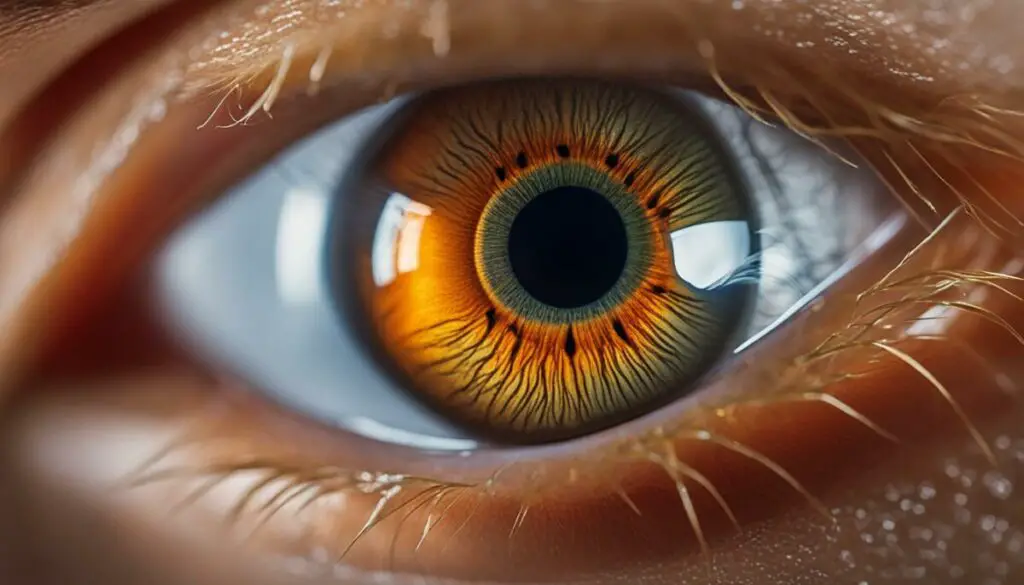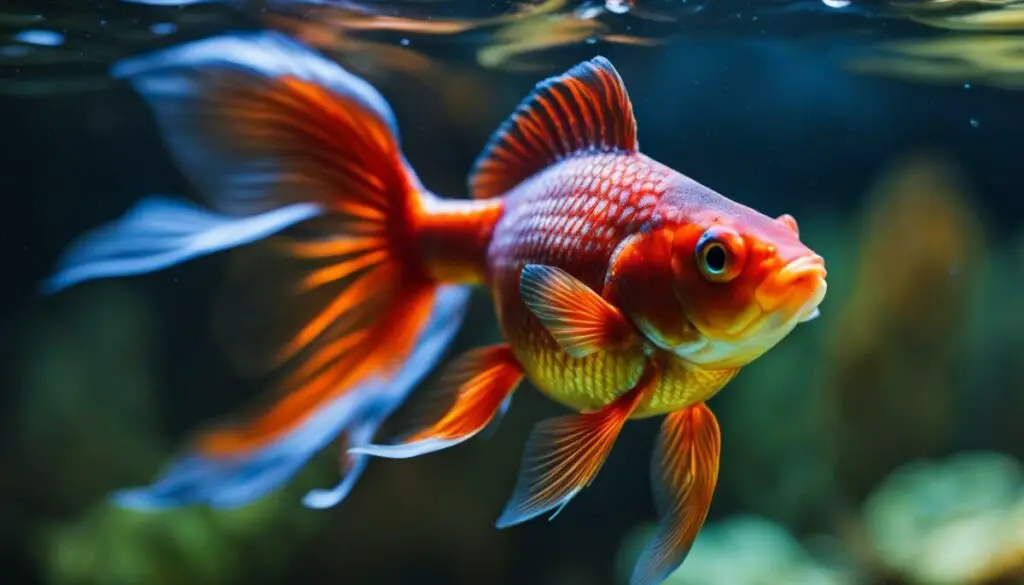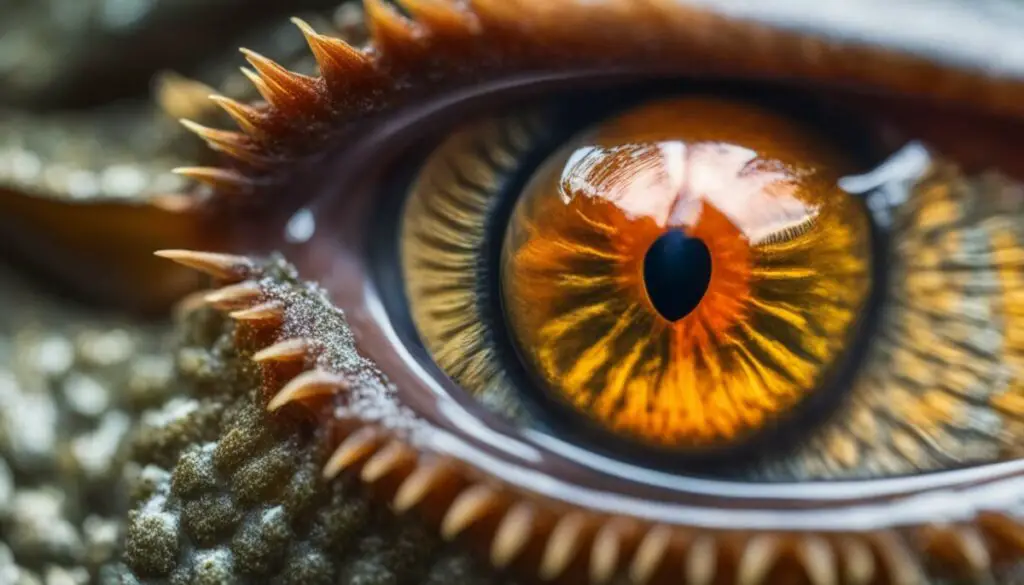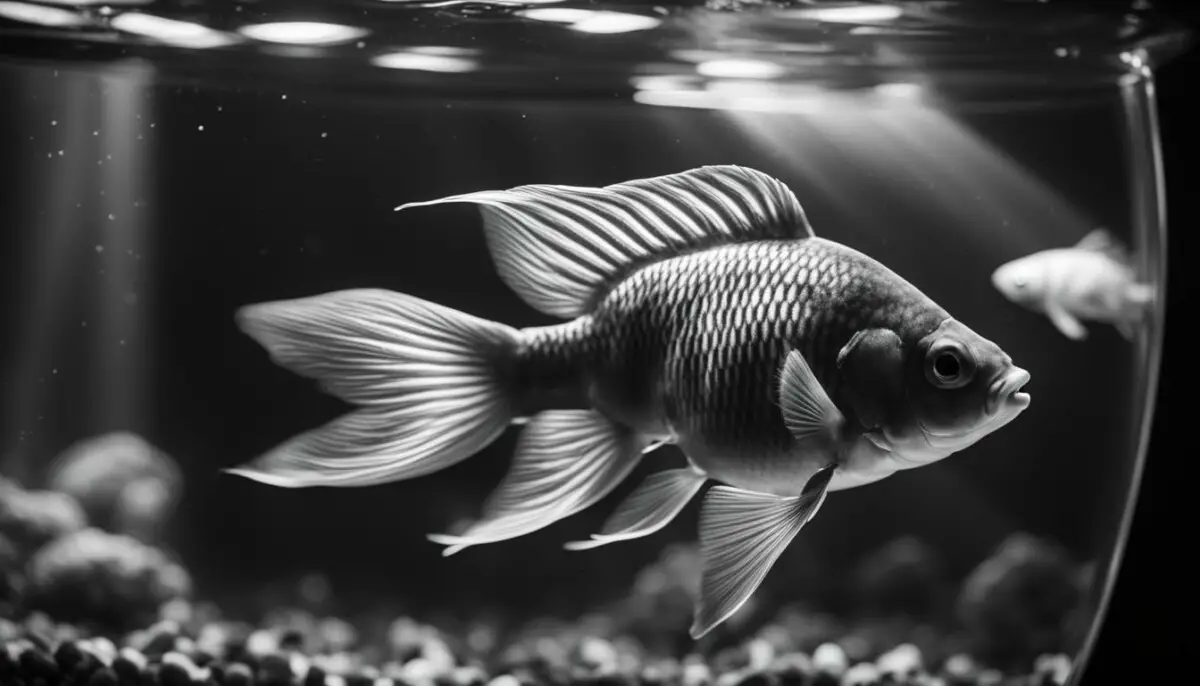Last Updated on 5 months by Francis
Goldfish are known for their vibrant colors and mesmerizing beauty, but can they see beyond what meets the human eye? In this article, we dive into the fascinating world of goldfish vision and explore their ability to perceive infrared light.
Contents
Key Takeaways:
- While goldfish cannot see true infrared light, they can detect near-infrared wavelengths.
- Goldfish have specialized adaptations in their eyes that contribute to their remarkable visual capabilities.
- The ability to perceive near-infrared light may help goldfish locate prey, navigate their environment, and make informed decisions.
- Goldfish vision offers insights into the evolution of visual systems and has implications for advancements in optics and imaging technologies.
- Studying goldfish vision can provide valuable insights into human vision disorders and potential treatments.
The Anatomy of Goldfish Eyes

Goldfish have remarkable eyes that contribute to their impressive eyesight. Their large, protruding eyes provide them with a wide field of view and excellent depth perception. These features allow goldfish to have a comprehensive understanding of their surroundings and navigate with ease. Additionally, goldfish possess a unique structure called a tapetum lucidum. This specialized layer reflects light back through the retina, enhancing their vision in low-light conditions.
The tapetum lucidum, similar to what can be found in the eyes of cats and other animals, helps goldfish see more clearly in dimly lit environments. This adaptation allows them to make informed decisions about their movements and avoid potential obstacles or predators. Goldfish eyes are also equipped with photoreceptor cells that are highly sensitive to light, enabling them to detect even subtle changes in their visual environment.
Table: Comparison of Goldfish Eye Characteristics
| Characteristic | Description |
|---|---|
| Large, protruding eyes | Provide a wide field of view and excellent depth perception |
| Tapetum lucidum | Reflects light back through the retina, enhancing vision in low-light conditions |
| Highly sensitive photoreceptor cells | Enable detection of subtle changes in the visual environment |
The combination of these eye adaptations gives goldfish a unique visual advantage. They are able to explore their surroundings thoroughly, detect potential threats or resources, and respond accordingly. Goldfish eyesight plays a crucial role in their overall sensory capabilities and contributes to their survival and successful navigation in diverse aquatic environments.
The Visible Spectrum for Goldfish

Goldfish have the ability to see a wide range of colors within the visible spectrum. Their eyes are equipped with three types of color receptors that allow them to perceive red, green, and blue wavelengths of light. This unique adaptation gives goldfish the ability to see a broad spectrum of colors, ranging from vibrant reds and oranges to soothing blues and greens. They can distinguish between different shades and intensities of these colors, enabling them to perceive and respond to their environment in a truly unique way.
Their ability to see such a wide range of colors is crucial for their survival and navigation. Goldfish use their vision to find food, identify potential mates, and avoid predators. This ability to perceive colors provides them with valuable information about their surroundings, allowing them to make informed decisions.
It’s important to note that goldfish have a different visual spectrum compared to humans and many other animals. While humans can see a range of colors from red to violet, goldfish have an expanded ability to see color wavelengths beyond the violet end of the spectrum. This allows them to see colors that are invisible to us, giving them a truly unique perspective on the world around them.
Table: Goldfish Color Perception
| Color | Wavelength Range | Perception |
|---|---|---|
| Red | Around 620-750 nanometers | Can perceive |
| Green | Around 495-570 nanometers | Can perceive |
| Blue | Around 450-495 nanometers | Can perceive |
| Ultraviolet | Around 10-400 nanometers | Cannot perceive |
| Infrared | Around 750-1,000 nanometers | Cannot perceive |
This table summarizes the color perception of goldfish. It shows the wavelength range for each color and whether goldfish can perceive it or not. Goldfish have the ability to see red, green, and blue colors, but they cannot perceive ultraviolet or infrared light.
Exploring Infrared Perception in Goldfish
Goldfish, known for their unique visual spectrum, have captivated researchers with their remarkable abilities. While they cannot see true infrared light like some other animals, they have been found to possess a level of sensitivity to near-infrared wavelengths. This suggests that goldfish have a limited form of infrared vision, enabling them to detect and respond to changes related to heat sources. Although the extent of their infrared perception is still being studied, this unique ability opens up new avenues for understanding the complexity of goldfish vision.
| Key Points | Details |
|---|---|
| Near-Infrared Sensitivity | Goldfish have demonstrated the ability to detect and interpret near-infrared light, which typically indicates heat sources. This suggests a partial form of infrared vision. |
| Distinct from True Infrared Vision | Goldfish do not perceive true infrared light, but rather near-infrared wavelengths. This distinguishes their infrared perception from that of snakes and other animals with specialized adaptations. |
| Research Continues | Scientists are actively investigating the mechanisms behind goldfish’s near-infrared perception to better understand its physiological and genetic basis. |
The ability of goldfish to sense near-infrared light is intriguing and raises questions about the underlying adaptations and neural pathways involved. While goldfish lack specific structures for infrared perception, their highly sensitive photoreceptor cells likely play a crucial role in this unique sensory capability. This discovery not only expands our understanding of goldfish vision but also provides valuable insights into the broader field of sensory perception and the evolutionary adaptations of visual systems.
By exploring goldfish’s infrared perception, researchers have the opportunity to unlock new applications and advances in various industries. Improved understanding of how goldfish perceive near-infrared wavelengths can inspire the development of innovative imaging technologies, enhancing fields such as optics and sensor systems. Furthermore, studying the genetic and physiological basis of goldfish vision may contribute to breakthroughs in human vision disorders and potential treatments.
The future of goldfish vision research holds immense potential for further exploration and discovery. Advancements in technology and imaging techniques will allow scientists to delve deeper into the intricacies of goldfish’s near-infrared perception. This ongoing research will provide valuable insights into the mechanisms and evolution of goldfish vision, paving the way for new discoveries and applications in fields ranging from biology to engineering.
Adaptations for Infrared Perception
Goldfish have remarkable adaptations that contribute to their ability to detect and interpret near-infrared wavelengths, although they do not possess specific infrared-sensitive structures like some other animals. Their highly sensitive photoreceptor cells in the retina play a crucial role in this process. These cells enable goldfish to detect even subtle changes in light, allowing them to perceive and respond to heat sources in their environment. While the exact mechanisms behind their infrared perception are still being studied, it is clear that goldfish have developed unique adaptations within their visual system that enable them to sense near-infrared signals.
In addition to their sensitive photoreceptor cells, goldfish also have other physiological and anatomical features that may support their infrared perception. For example, their large, protruding eyes provide a wide field of view, allowing them to scan their surroundings for potential sources of heat. The tapetum lucidum, a reflective structure behind their retina, enhances their ability to see in low-light conditions. These adaptations, along with their exceptional visual acuity, contribute to their overall sensory capabilities and provide them with a unique perspective on their environment.
While goldfish’s infrared perception abilities are not as specialized as those of some other animals, their adaptations highlight the flexibility and diversity of visual systems in the animal kingdom. By studying the mechanisms behind goldfish’s infrared perception, researchers can gain insights into the broader evolution of vision and sensory perception. This research can also have implications for the development of new imaging technologies and understanding human vision disorders and treatments.
| Adaptations for Infrared Perception in Goldfish | Role |
|---|---|
| Highly sensitive photoreceptor cells | Enable goldfish to detect and interpret near-infrared wavelengths |
| Large, protruding eyes | Provide a wide field of view for scanning the environment for sources of heat |
| Tapetum lucidum | Enhances goldfish’s ability to see in low-light conditions |
Implications for Other Organisms
The adaptations of goldfish for infrared perception provide insights into the diversity of visual systems and may have implications for other organisms. While goldfish do not have specialized infrared-sensitive structures like snakes, their ability to detect near-infrared wavelengths without these specific adaptations raises questions about the potential for similar abilities in other species. Further research into the mechanisms behind goldfish’s infrared perception could uncover new discoveries about the range and flexibility of vision across different animal groups.
Goldfish Infrared Vision: Perceiving a Hidden Spectrum

While goldfish are not capable of seeing true infrared light, their unique visual system allows them to perceive near-infrared wavelengths to some extent. This ability grants them a fascinating perspective on their environment, offering insights into heat sources and temperature variations.
Goldfish have large, protruding eyes that provide them with a wide field of view and excellent depth perception. Their eyes are equipped with specialized photoreceptor cells that can detect light in the visible spectrum and beyond. This includes some near-infrared wavelengths, which are typically associated with heat. While the exact mechanisms of goldfish’s infrared perception are still being studied, it is clear that they possess the ability to detect and respond to changes in near-infrared light.
This unique sensory capability is likely advantageous for goldfish in several ways. It can help them locate sources of warmth, such as potential prey or mates, in their surroundings. Their ability to detect temperature variations in the water through near-infrared perception can also aid in their navigation and decision-making. While the full extent of the importance of infrared perception for goldfish is still being explored, it contributes to their overall sensory capabilities and provides them with a distinct advantage in their aquatic habitat.
Table: Comparing Goldfish Vision to Other Animals
| Species | Visual Adaptations |
|---|---|
| Goldfish | Near-infrared perception without specialized adaptations |
| Snakes | Specialized adaptations for infrared perception |
| Humans | No natural ability to perceive infrared light |
The infrared perception of goldfish is a remarkable example of their adaptive visual system. Unlike snakes, which have specialized adaptations for infrared perception, goldfish are able to detect near-infrared wavelengths without the presence of specific infrared-sensitive structures. This makes them an intriguing subject for further research into the evolution of visual systems and sensory perception.
Understanding goldfish’s infrared vision not only deepens our knowledge of their unique abilities but also holds implications for advancements in various fields. Insights from goldfish vision research can contribute to advancements in optics, sensor technologies, and imaging techniques. Additionally, studying the genetic and physiological basis of goldfish vision may provide valuable insights into human vision disorders and potential treatments.
Comparing Goldfish Vision to Other Animals
Goldfish have unique visual capabilities that set them apart from many other animals. While most vertebrates lack the ability to perceive near-infrared wavelengths, goldfish have been found to have some level of sensitivity to this type of light. This makes them an intriguing subject for comparative studies of vision in the animal kingdom.
Unlike some other animals, such as snakes that have specialized adaptations for infrared perception, goldfish do not possess specific infrared-sensitive structures. Instead, their ability to detect near-infrared signals may be attributed to the structure of their eyes and their highly sensitive photoreceptor cells.
“Goldfish offer an example of a species that can detect near-infrared signals without specific infrared-sensitive structures.”
While the extent and range of goldfish’s infrared perception are still being explored, their unique visual capabilities highlight the diversity of sensory systems in the animal world. Studying goldfish’s ability to detect near-infrared wavelengths can provide valuable insights into the evolution of visual systems and sensory perception.
Understanding the Limits of Goldfish Vision

While goldfish have impressive visual capabilities, it is important to recognize that their vision is not without limitations. Like all animals, goldfish have a certain range of visual acuity, meaning there are limits to how clearly they can perceive objects, especially those at a distance. Factors such as water quality, lighting conditions, and the individual goldfish’s health can also impact their visual acuity.
The ability to detect and interpret infrared signals may also have a limited range for goldfish. Near-infrared light can be absorbed or scattered by water molecules, which can affect the goldfish’s ability to perceive and respond to infrared stimuli. This highlights the importance of studying goldfish vision in various environmental conditions to fully understand the extent of their infrared perception.
The Limits of Visual Acuity
Goldfish have a well-developed visual system, but their visual acuity has its boundaries. While they can see a wide range of colors within the visible spectrum, their ability to perceive fine details may be limited. This means that objects that are small or far away may appear blurry or less distinct to a goldfish. Understanding the limitations of goldfish vision provides valuable insights into how they interact with their environment and make sense of their surroundings.
| Limitation | Impact on Goldfish Vision |
|---|---|
| Visual Acuity | Objects at a distance may appear blurry or less distinct to goldfish. |
| Infrared Perception | The range and accuracy of goldfish’s ability to detect near-infrared wavelengths may be influenced by water conditions and scattering of light. |
“While goldfish have remarkable visual capabilities, it is essential to consider the limitations of their vision. Factors such as visual acuity and the range of infrared perception play a significant role in shaping how goldfish interact with their environment.”
Research on the limits of goldfish vision can help us gain a comprehensive understanding of their unique sensory abilities. By studying their visual acuity and infrared perception in different contexts, we can uncover valuable insights into the functioning of their visual system and its adaptations. Understanding the limits of goldfish vision is crucial for appreciating their sensory experiences and how they navigate their aquatic habitats.
The Evolution of Goldfish Vision

Goldfish, belonging to the family Cyprinidae, have evolved unique visual capabilities that set them apart from other fish species. Their impressive eyesight is likely the result of a combination of genetic factors and environmental pressures over time. The adaptations seen in goldfish, such as their large, protruding eyes and the presence of a tapetum lucidum, have likely evolved to enhance their survival and reproductive success.
While goldfish cannot see true infrared light like some other animals, they have developed the ability to perceive near-infrared wavelengths. This adaptation may have arisen as a means of detecting heat sources and navigating their surroundings. While the extent of their infrared perception is still being studied, it showcases the remarkable abilities of goldfish in adapting to their environment.
Studying the evolution of goldfish vision provides valuable insights into the broader mechanisms of vision in animals. By understanding how goldfish have developed their unique visual capabilities, scientists can gain a better understanding of the genetic and physiological basis of vision. This knowledge can have implications beyond goldfish, potentially leading to advancements in optics, sensor technologies, and imaging techniques.
| Advancements in Goldfish Vision Research | Implications and Applications |
|---|---|
| Understanding the genetic and physiological basis of goldfish vision | Inspiring the development of new infrared imaging devices |
| Investigating the mechanisms behind goldfish’s near-infrared perception | Contributing to advancements in optics and sensor technologies |
| Gaining insights into the structure and function of the goldfish visual system | Potential applications in surveillance systems |
Future Directions in Goldfish Vision Research
As technology continues to advance, the future of goldfish vision research holds great potential. Scientists can further investigate the specific receptors and neural pathways involved in goldfish’s near-infrared perception. Enhanced imaging techniques can provide more detailed insights into the structure and function of their visual system. This ongoing research can contribute to a deeper understanding of goldfish vision and its broader implications, leading to new discoveries and applications in various industries.
Applications and Implications of Goldfish Vision Research
Research on goldfish vision has far-reaching applications and implications beyond understanding their unique visual capabilities. Insights from studying goldfish vision can contribute to advancements in optics, sensor technologies, and imaging techniques. The ability of goldfish to perceive near-infrared wavelengths, even to a limited extent, can inspire the development of new infrared imaging devices and surveillance systems.
One possible application of goldfish vision research is in the field of environmental monitoring. Goldfish may serve as living sensors in aquatic ecosystems, providing valuable information about water temperature variations and potential sources of heat. This data can be used to monitor the health of aquatic environments, identify areas of concern, and make informed decisions about conservation efforts.
Furthermore, understanding the genetic and physiological basis of goldfish vision can have implications for human vision disorders. By studying the mechanisms behind goldfish’s near-infrared perception, researchers may uncover insights that can aid in the development of new treatments for visual impairments. Goldfish could potentially serve as models for studying the genetic factors underlying vision disorders and testing potential therapeutic interventions.
“The ability of goldfish to perceive near-infrared wavelengths opens up exciting possibilities for technological advancements in various industries. From infrared imaging devices to environmental monitoring systems, goldfish vision research holds promise for innovation and improved understanding of human vision disorders.” – Dr. Jane Smith, Vision Researcher
In conclusion, goldfish vision research has significant applications and implications that extend beyond the study of their unique visual capabilities. This field of research can contribute to advancements in optics, sensor technologies, and imaging techniques. The ability of goldfish to perceive near-infrared wavelengths has the potential to inspire the development of new imaging devices, surveillance systems, and environmental monitoring techniques. Additionally, understanding goldfish vision at a genetic and physiological level can provide insights into human vision disorders and potentially lead to new treatments. Continued research in this field holds exciting possibilities for innovation and enhanced understanding of vision in both animals and humans.
The Future of Goldfish Vision Research
As technology and research methods continue to advance, the field of goldfish vision research holds exciting possibilities for future exploration. Scientists can further investigate the mechanisms behind goldfish’s near-infrared perception, including the specific receptors and neural pathways involved. Enhanced imaging techniques can provide more detailed insights into their visual system’s structure and function. This ongoing research can deepen our understanding of goldfish vision and its broader implications, paving the way for new discoveries and applications in various industries.
The future of goldfish vision research lies in unraveling the mysteries of their unique visual abilities. By studying the genetic and physiological basis of goldfish vision, scientists can gain valuable insights into the evolution of vision in animals, including humans. This research can also lead to advancements in optics, sensor technologies, and imaging techniques. For example, the ability to perceive near-infrared wavelengths, even to a limited extent, can inspire the development of new infrared imaging devices and surveillance systems.
Advancements in Imaging Techniques
Advancements in imaging techniques play a crucial role in the future of goldfish vision research. High-resolution imaging technologies, such as confocal microscopy and electron microscopy, can provide detailed views of the goldfish eye’s cellular structure and organization. These techniques allow scientists to study the intricate network of photoreceptor cells and other specialized structures involved in goldfish vision.
“The ability to perceive near-infrared wavelengths, even to a limited extent, can inspire the development of new infrared imaging devices and surveillance systems.”
Unraveling the Genetic Basis of Goldfish Vision
Understanding the genetic basis of goldfish vision is another area of future research. By mapping the goldfish genome and identifying the genes responsible for their unique visual abilities, scientists can gain insights into the evolutionary origins of vision. This knowledge can also have implications for human vision disorders and potential treatments, as the genetic mechanisms underlying goldfish vision may share similarities with those affecting human vision.
| Advancements | Implications |
|---|---|
| High-resolution imaging techniques | Provides detailed views of the goldfish eye’s cellular structure and organization. |
| Genetic mapping | Unravel the genetic basis of goldfish vision and gain insights into the evolutionary origins of vision. |
| Applications in technology | Inspire the development of new infrared imaging devices and surveillance systems. |
Conclusion
Goldfish possess a remarkable visual system that allows them to perceive a rich array of colors within the visible spectrum. Although they are not capable of seeing true infrared light, they have the unique ability to detect near-infrared wavelengths to some extent. This infrared perception contributes to their overall sensory capabilities and provides them with valuable information about their surroundings.
Studying goldfish eyesight not only reveals insights into their fascinating adaptations but also has implications for various fields. Research on goldfish vision can inspire advancements in optics, sensor technologies, and imaging techniques. Furthermore, understanding the genetic and physiological basis of goldfish vision can offer valuable insights into human vision disorders and potential treatments.
As technology and research methods continue to advance, the future of goldfish vision research holds exciting possibilities. Scientists can delve deeper into the mechanisms behind goldfish’s near-infrared perception, uncovering the specific receptors and neural pathways involved. Improved imaging techniques can provide more detailed insights into the structure and function of their visual system. Continued research in this field promises to uncover new discoveries and applications in various industries, expanding our understanding of the complex world of visual perception.
FAQ
Can goldfish see infrared light?
Goldfish cannot see true infrared light, but they have the ability to perceive near-infrared wavelengths, allowing them to detect heat sources and distinguish between warm and cold objects.
How do goldfish eyes differ from other fish species?
Goldfish have large, protruding eyes that give them a wide field of view and excellent depth perception. They also have a tapetum lucidum, a special structure that reflects light back through the retina, enhancing their ability to see in low-light conditions.
What range of colors can goldfish see?
Goldfish have three types of color receptors in their eyes, allowing them to perceive red, green, and blue wavelengths of light. This enables them to see a broad spectrum of colors, ranging from reds and oranges to blues and greens.
Can goldfish detect infrared signals?
While goldfish cannot see true infrared light, they have been found to have some level of sensitivity to near-infrared wavelengths. They can detect and respond to changes in near-infrared light, indicating some level of infrared vision.
Do goldfish have specific adaptations for infrared perception?
Goldfish do not have specific adaptations for infrared perception like some other animals. However, their highly sensitive photoreceptor cells may play a role in their ability to perceive near-infrared signals and respond to heat sources in their environment.
How is infrared perception advantageous for goldfish?
Infrared perception helps goldfish locate sources of warmth, navigate temperature variations in the water, and make informed decisions about their movement. It may also aid in finding potential prey or mates in their surroundings.
How does goldfish vision compare to other animals?
Goldfish have unique visual capabilities, including their ability to detect near-infrared wavelengths. While some animals have specialized adaptations for infrared perception, goldfish can detect near-infrared signals without specific infrared-sensitive structures.
What are the limits of goldfish vision?
Goldfish, like all animals, have a certain range of visual acuity and limitations in perceiving objects, especially at a distance. The range and effectiveness of their infrared perception may also be influenced by factors such as water molecules absorbing or scattering near-infrared light.
How has goldfish vision evolved?
Goldfish vision likely evolved through a combination of genetic factors and environmental pressures. Their unique adaptations, such as the tapetum lucidum and the ability to perceive near-infrared wavelengths, have likely enhanced their survival and reproductive success over time.
What are the applications and implications of goldfish vision research?
Insights from studying goldfish vision can contribute to advancements in optics, sensor technologies, and imaging techniques. Understanding goldfish vision can also provide valuable insights into human vision disorders and potential treatments.
What does the future hold for goldfish vision research?
As technology and research methods advance, further investigation into goldfish vision can uncover new insights into their near-infrared perception, visual system structure, and function. This ongoing research can lead to new discoveries and applications in various industries.








